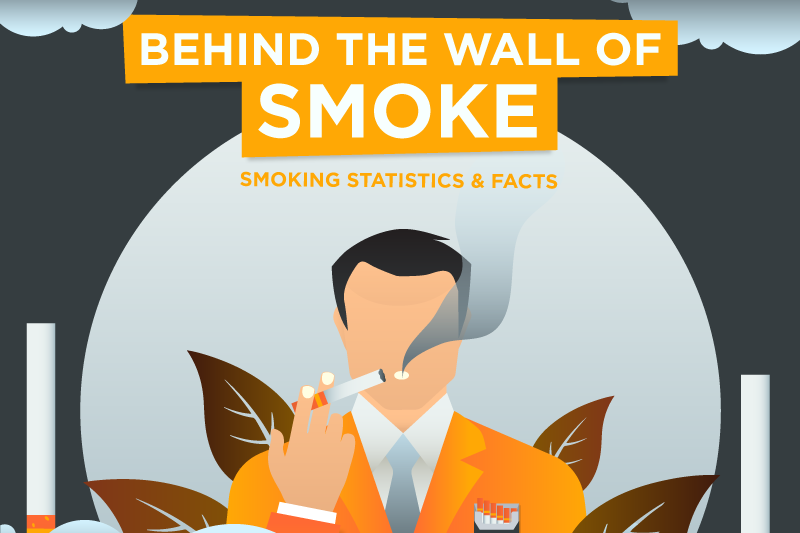[vc_row][vc_column][vc_column_text]Everyone is aware of the dangers of smoking and tobacco use, but there are still millions of people who smoke, which the smoking statistics confirm.
But did you know that cigarettes have more than 600 ingredients? Most of them are also found in cigars and hookahs. Did you also know that they become poisonous chemicals when burned?
Keep scrolling to discover more interesting, scary, and, above all, vital facts and stats about smoking and tobacco.
But first, let’s take a look at some of the most important figures and facts on smoking.
The 10 Key Smoking Statistics and Facts
- One single cigarette has about 4 milligrams of nicotine, which is enough to create an addiction.
- Smoking cigarettes will decrease your life expectancy by 13 years, on average.
- More than 100 million people around the world have died during the 20th century due to tobacco use.
- More than 16 million Americans suffer from an illness caused by smoking.
- It’s estimated that at least 5.6 million children in the US alone will die from illnesses caused by smoking.
- Secondhand smoking statistics claim that every year more than 41,000 people die from secondhand cigarette smoke.
- It’s estimated that 1 in every 5 adults in the world use tobacco.
- Every minute, 10 million cigarettes are sold worldwide.
- Research reveals that between 12% and 20% of pregnant women smoke.
- Approximately 68% of smokers in the United States admit they want to quit.
If you want to learn more about what health issues cigarette smoking can cause, how to treat them, and how exactly smoking kills, keep reading.[/vc_column_text][/vc_column][/vc_row][vc_row][vc_column][vc_single_image image=”823″ img_size=”full” alignment=”center”][/vc_column][/vc_row][vc_row][vc_column][vc_column_text]
Overall Facts and Statistics About Smoking
1. Tobacco started growing in approximately 6,000 BCE in the Americas.
(Boston University)
What’s more, it belongs in the same plant family as pepper, potatoes, and a poisonous nightshade.
Tobacco’s seeds are so small, there are over 300,000 in just one ounce.
The very first tobacco users were the Native Americans, who used it for religious rituals and for medicinal purposes.
Throughout the history of tobacco, we can see that it was also used for treating different wounds, and even as a pain-killer.
Tobacco chewing was even recommended for toothaches.
2. Columbus brought tobacco to Europe.
(Cancer Council)
He was also the first European to learn that tobacco could be smoked.
Europeans then started cultivating the plant, and by the 1600s, tobacco spread across the whole of Europe.
Some tobacco facts show that it was even used instead of money. By the 1700s, Europeans had a whole tobacco industry, and smoking was a common sight.
3. Nowadays, approximately 9 out of 10 smokers tried their first cigarette while still in high school.
(CDC)
Tobacco use typically starts and establishes itself during adolescence. That’s why the prevention of tobacco use in this age group is crucial for stopping this epidemic.
Cigarette smokers very often try their first cigarette before they graduate high school, and for 98% of smokers, their first time smoking was at age 26 or younger.
4. A single cigarette can deliver 1 milligram of nicotine, which is enough to lead to addiction.
(STAND AZ)
Furthermore, nicotine addiction can cause some serious health problems. These include heart disease, various types of cancer, stroke, diabetes, and different lung diseases like bronchitis, emphysema, or chronic airway obstruction.
5. Smoking cigarettes will decrease your life expectancy by 13 years, on average.
(Verywell Mind) (Very Well Mind)
Moreover, if you’re a smoker who also has HIV, smoking death statistics claim that this will cut your life expectancy by 16 years, on average.
The WHO states that more than 50% of tobacco users will die of causes related to their addiction.
6. More than 100 million people around the world have died during the 20th century due to tobacco use.
(Verywell Mind)
If things don’t change, it’s estimated that by the end of the 21st century, this number will include another billion.
This is why it’s of great importance to make every effort possible to campaign against smoking on a global level.
Smoking Statistics in the US
7. Over 27% of US high schoolers use one or more tobacco products.
(American Lung Association)
Additionally, more than 7% of middle school students use at least one. This number also includes e-cigarettes, as the National Youth Tobacco Survey from 2018 has discovered.
The same survey also revealed that in just one year, the use of e-cigarettes among high school students has increased by 78%.
In addition, teen smoking statistics say that e-cigarette use has risen by 50% among middle school students.
8. More than 16 million Americans suffer from an illness that was caused by smoking.
(CDC)
Tobacco use is harmful to every organ in the human body. Besides the illnesses we’ve mentioned, it also causes various disabilities.
For every individual who dies of a smoking-induced medical problem, there are at least 30 people who live with an illness or disability caused by tobacco use, as the CDC smoking statistics show.
9. It’s estimated that at least 5.6 million children in the US alone will die from illnesses caused by smoking.
(Verywell Mind)
This equates to 1 in every 13 children. Even though the number of young people who smoke continues to decrease, still more than 3,000 adolescents try their first cigarette every day, and more than 2,000 of them continue smoking.
10. Smoking statistics by year report that the general tobacco use among young people has decreased by approximately 5% from 2013 to 2018.
(CDC)
In 2013, 17.7% of middle school students, and 46% of high school students admitted to trying some kind of tobacco product.
Those numbers have fallen, and in 2018 it was 12.5% of middle school and 31.2% of high school students.
However, 2.4% of middle school and 11.3% of high school students use more than one tobacco product, as the smoking demographics by age show.
11. In the USA, the cigarettes industry spent $9.36 billion in 2017 just on advertising.
(CDC)
Every year the industry spends billions of dollars on cigarettes and smokeless tobacco advertising and promotions.
To put it more simply, every day the tobacco industry spent over $25 million on advertising. That’s more than $1 million every hour.
Approximately 71.7% of their marketing expenses account for the discounts they give to retailers to lower cigarette prices for their customers.
12. The tobacco industry has a $300 billion economic impact on the US every year.
(Verywell Mind)
The US tobacco industry may be spending billions on advertisements, but it’s also costing the national economy.
Every year, the country’s smoking-related expenditures were $170 billion due to diseases and disabilities caused by smoking. In addition, it cost the US over $156 billion in lost productivity due to tobacco-related illness and even death.
13. US states will collect more than $27 billion from tobacco product taxes, as the smoking statistics by state report.
(CDC)
This is the total for 2019, specifically. Every year, the US collects billions of dollars from tobacco taxes and lawsuits against cigarette companies.
However, when it comes to spending that money on programs for smoking prevention, and programs that can help current smokers quit, the country will spend $655 million in 2019, which is less than 2.4% of the money they’ve collected.
The US needs to spend just 12% of this total ($3.3 billion) for every state to fund a tobacco control program.
14. Smoking statistics claim that every year more than 41,000 people die from secondhand cigarette smoke.
(American Lung Association)
Secondhand smoke is a serious health risk for everyone who surrounds smokers. It can worsen already existing health issues, and it can even cause new ones.
Over 2.5 million people died from 1964 to 2014 from secondhand smoke.
Even short-term exposure to secondhand smoke can cause various health problems, and it’s a major cause of stroke.
15. An interesting fact about smoking in the 1950s, statistics show that smoking in the US peaked in 1954, when 45% of the US population consumed tobacco.
(Gallup)
Since the ’50s and all throughout the 1970s, smoking rates in America have been at around 40%.
Smoking started to decline during the ’70s, and it fell to 32% in the 1980s. American adults started to quit or avoid smoking, and the trend declined even more in the ’90s, falling to 26%.
The rate has since dropped further, and from the 2000s onwards, it’s been around 24%.
Smoking Statistics Worldwide
16. Approximately 80% of smokers around the world live in middle- and low-income countries.
(WHO)
The tobacco epidemic is estimated to be the greatest one in the world, and the weight of it’s heaviest in low- and middle-income countries.
The tobacco addiction among poor people in these countries is so grave that they’d rather buy cigarettes than food and life supplies.
17. It’s estimated that 1 in every 5 adults in the world use tobacco.
(Our World in Data)
Smoking statistics by country reveal that 20% of the world’s population smokes.
The countries where more than 40% of the population uses tobacco are Kiribati, with 47% of the population, Montenegro with 46%, Greece and Timor with 43% each, and Nauru with 40% of the population being addicted.
However, less than 5% of the population in Ethiopia, Ghana, Peru, and Honduras use tobacco products.
18. Every minute, 10 million cigarettes are sold worldwide.
(Verywell Mind)
The latest smoking statistics from 2018 also show that this adds up to 15 billion sold cigarettes every day, which means that every year the world produces and consumes up to 5 trillion cigarettes.
19. 35% of men worldwide are smokers.
(Our World in Data)
Research shows that more than one third of the world’s male population smokes. Only 6% of women smoke on a global scale.
This is the case for almost all countries around the globe. However, women on the Pacific island of Nauru outnumber male smokers.
Comparing the percentage of smokers by state, territory, or country, we see that 43% of women in Nauru smoke, compared to 37% of men.
Meanwhile, in Sweden and Denmark, there’s almost no difference between the number of male and female smokers.
20. It’s estimated that there are more than 300 million smokers in China.
(Verywell Mind)
Every year, they consume more than 1.7 trillion cigarettes, which means they smoke around 3 million cigarettes every minute.
This also means that one in every three smoked cigarettes in the world is in China. Additionally, recent smoking facts and statistics estimate that one quarter of young people living in Oceania, the Pacific, and East Asia (the Western Pacific Region) will die from using tobacco.
21. Just 1 in every 3 countries in the world regularly monitors tobacco use.
(WHO)
To simplify, this means that 38% of the global population is regularly (once every 5 years) evaluated for tobacco use in youth and adult surveys.
Consistent monitoring of tobacco use can help governments create policies resolving the tobacco epidemic.
Smoking During Pregnancy: Statistics and Facts
22. Research reveals that between 12% and 20% of pregnant women smoke.
(American Pregnancy Association)
When the mother smokes, the baby must as well. Babies absorb all of the dangerous chemicals from cigarettes through the placenta, which is responsible for sending nutrients and oxygen to the baby.
This prevents the baby from developing properly and causes numerous health issues, even death.
23. In the US, pregnant women aged 20–24 have a 10.7% prevalence of smoking during pregnancy.
(CDC)
According to the smoking facts, this group of women is the most likely to smoke while pregnant.
Pregnant women aged 15–19 follow with 8.5%, and the lowest percentage covers pregnant women aged 25–29, at 8.2%.
In addition to this, Native American or Alaska Native women also have the highest prevalence of smoking during pregnancy, at 16.7%.
On the other hand, Asian women have the lowest prevalence, at 0.6%.
24. Smoking statistics show that approximately 300,000 babies in the US die every year due to low birth weight caused by smoking.
(Verywell Mind)
Smoking, as well as exposure to secondhand smoke, prevents the baby from developing properly, which further leads to low weight at birth, and in thousands of cases, death.
In addition to this, smoking during pregnancy can also worsen the risk of miscarriage, ectopic pregnancy, and stillbirth.
Furthermore, cigarette smoking statistics show that it can lead to placenta previa, premature rupture of amniotic membranes, cleft lip or palate, and numerous other defects and disabilities.
25. Only 1% of women with at least a bachelor’s degree were likely to smoke during pregnancy.
(CDC)
The higher the woman’s education, the lower her chances of smoking during pregnancy.
The highest prevalence for smoking while pregnant is among women with a high school diploma or GED, at 12.2%.
Smoking statistics from 2017 also show that they’re followed by women with less than a high school diploma, at 11.7%, and women with some college or an associate’s degree, at 7.9%.
26. Around 7% of women use e-cigarettes during their pregnancy.
(CDC)
Additionally, 1.4% of pregnant women use e-cigarettes during their last trimester. Now, e-cigarettes and pregnancy are also a dangerous combination.
Even though e-cigarettes are believed to be a bit less dangerous than traditional cigarettes, they still contain nicotine, and our facts about smoking have already mentioned how dangerous this is for a baby.
27. Pregnant women who smoke have a 1.4–2.4 times greater chance of a placenta abruption occurring.
(Verywell Mind)
This condition happens when the placenta prematurely detaches from the uterus. Placenta abrupta can cause premature birth, stillbirth, or early infant death. Babies who are born to mothers who were smoking during their pregnancies also have an increased risk for sudden infant death syndrome (SIDS).
Statistics on Smoking and Comorbidities
28. People who smoke have a 30%–40% greater chance of developing type 2 diabetes.
(CDC)
The more cigarettes a person smokes, the higher their chances of developing diabetes are.
Additionally, people who already suffer from diabetes and start smoking will have much more difficulty managing their illness.
Having diabetes and smoking can also cause other health issues like heart and kidney disease, retinopathy, and peripheral neuropathy, just to name a few.
29. According to smoking and lung cancer statistics, smoking is the main cause of 80%–90% of deaths caused by lung cancer.
(American Lung Association)
The same research shows that nonsmokers are 20%–30% more likely to develop lung cancer from secondhand smoke.
In addition to this, men who smoke are 23 times more likely to develop this type of cancer than nonsmokers, and women are 13 times more likely.
30. Smoking-induced cancers make up 40% of all cancer cases in the US.
(CDC)
As the smoking and cancer statistics report, the use of tobacco is the most preventable cause of cancer—and, consequently, of deaths caused by cancer.
And there’s not only a high risk of lung cancer, smokers can also develop cancers of the mouth and throat, stomach, kidney, pancreas, voice box, esophagus, liver, bladder, cervix, and colon and rectum, as well as acute myeloid leukemia.
31. It’s estimated that approximately 20% of deaths from heart disease are caused by smoking.
(Johns Hopkins)
Furthermore, smoking and heart disease statistics report that people who smoke have 2 to 4 times higher chances of developing heart disease than nonsmokers.
Additionally, smokers are also twice as likely to have a stroke, and women who smoke and take birth-control pills have a high risk of both heart disease and stroke.
32. Approximately 68% of smokers in the United States admit they want to quit.
(CDC)
Additionally, in the past year, 45.5% of all smokers in high school tried to quit smoking, statistics show.
Research shows that 66.7% of young smokers stopped smoking for more than one day in 2015 because they were trying to quit. This was also the case for 55.4% of adult smokers over 25.
33. Smokers who quit have more than a 50% chance of relapsing in the first year.
(NCBI)
With time, this possibility decreases, and research shows that after just one year of tobacco abstinence, these chances fall dramatically.
Furthermore, after 30 years or more of tobacco abstinence, there’s only a 10% chance of a relapse.
FAQ
Why do people smoke cigarettes?
As we’ve already mentioned, most people try their first cigarette while they’re still teenagers. The reasons vary greatly. Those who have parents, close family members, and friends who smoke are more likely to start smoking themselves. Some are just curious and want to try something new. Some are encouraged by smoking ads and campaigns or even the lure of affordable cigarettes, and some just want to be like their idols.
How many cigarettes does the average smoker smoke a day?
There’s no formal category that will make a distinction between a light, average, or heavy smoker. However, there are some general guidelines. People who smoke less than 10 cigarettes per day are considered light smokers. Those who smoke one pack or more a day, are considered to be heavy smokers, and the average smoker falls somewhere in between.
How many chemicals are in a cigarette?
As mentioned, there are over 600 ingredients in cigarettes. When they burn, they create more than 7,000 dangerous chemicals, out of which 69 are verified to cause cancer. Just a few of the chemicals in cigarettes include acetone, ammonia, arsenic, benzene, carbon monoxide, formaldehyde, lead, methanol, tar, toluene, and of course, nicotine.
What percentage of smokers will get cancer?
Research shows that less than 10% of lifelong smokers will develop lung cancer. Additionally, even fewer smokers are likely to develop one of the other types of cancer that smoking causes. However, this still doesn’t deny the already mentioned fact that smoking is the cause of 40% of all cancer cases in the US, and it’s the main cause of 80%–90% of lung cancer deaths.
How likely is smoking to kill you?
It’s almost certain that smoking will kill you, and there is no safe amount of exposure to smoking or secondhand smoke. When compared to nonsmokers, people who smoke less than half a cigarette pack have an 87% greater chance of dying prematurely.
How many people die from smoking?
More than 480,000 in the US alone die every year because of smoking. This accounts for one in every five deaths annually. Additionally, over 41,000 people die from secondhand smoke. If this trend continues, it’s estimated that more than 5.6 million Americans younger than 18 will suffer an early death.
What country has the most smokers?
Generally, Southeast Asia and the Balkan part of Europe have the highest percentage of smokers in the world. As mentioned, Kiribati has the highest smoking rate. In addition to this, they have more male than female smokers, and every day, this country loses more than 200 people due to cigarette-related causes.
The Bottom Line
Even if you’re a heavy smoker, it’s never too late to quit. Even though quitting is hard, it’s not impossible, and all the smoking statistics show that significant health improvements can be seen in a short period of time. Smoking changes the body, but it can be prevented with a healthy lifestyle. With the help of a doctor’s counsel, medication, various programs, and the support of friends and family, quitting is possible.
We hope that this list of statistics will prevent people from acquiring this bad habit, and help the ones who already smoke quit. It’s never too late to improve your quality of life.
Sources:
- American Lung Association
- American Lung Association
- American Lung Association
- American Lung Association
- American Pregnancy Association
- Boston University Medical Center
- Cancer
- Cancer Council NSW
- CDC
- CDC
- CDC
- CDC
- CDC
- CDC
- CDC
- Gallup
- John Hopkins Medicine
- Live Science
- NBC News
- NCBI
- Our World in Data
- Sharecare
- STAND AZ
- Verywell Mind
- Verywell Mind
- WHO
- World Population Review
[/vc_column_text][/vc_column][/vc_row]



